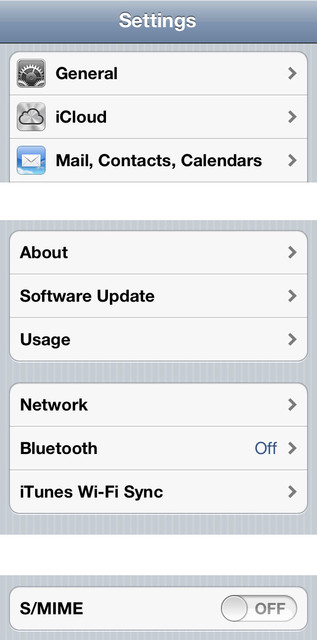
After a beta period of four months, Apple released iOS 5 in early October 2011. After two months of release, it’s time to put the heavily hyped features aside (Siri, I’m talking about you), step back, and take a look at the implications of this mobile operating system from an support perspective.
A Reference Release
Apple iOS 5 unifies the iOS in the United States for the first time since Apple brought Verizon into the iPhone fold. A unified OS brings many benefits: documentation and support are easier, app development can be more reasonably targeted, and developers of web-based applications can begin a move to at least optimizing for the current version of mobile Safari.
Transitioning From MobileMe To iCloud
iOS 5 is a major component of Apple’s transition from MobileMe to iCloud, with support for both synchronization services, at least in version 5.0.x. Of course, Apple desperately wants all Mobile Me users to transition to iCloud as soon as possible — in fact, they sent an “iCloud is here” message to all MobileMe users late in November. However, there are challenges for many MobileMe users — many MobileMe services are either being changed or being removed (iDisk, Gallery, iWeb publishing, and many sync services). Finally, previous purchases may be unavailable through iCloud if they are no longer available in the iTunes Store, App Store, or iBookstore.
iCloud also introduces full device backup to the cloud. Some organizations may decide that trusting their backups and thus their data to Apple does not match their regulatory requirements. Luckily, iCloud backup capability can be controlled through mobile device management.
It is reasonable to expect that iOS 6 will only support iCloud. The MobileMe service itself is going away on June 30, 2012.
PC-Free And What It Means
Going “PC-Free” puts Apple (finally) into a more competitive position versus Android and Blackberry devices. This capability will at least allow the potential for using iPhones and (especially) iPads as truly independent devices. It marks the beginning of the end for Apple’s traditional desktop synchronization method – something in use since October 2001 with the release of the original iPod.
Initial setup and configuration no longer requires connecting to a Mac OS or Windows system with a current version of iTunes installed. In many ways, it now resembles the Mac OS setup experience: the user connects to a network, chooses whether they are restoring from backup or starting from scratch, and registers with Apple.
For those who don’t want to completely rid themselves of iTunes but want a little more convenience, WiFi synchronization is now available.
New Features
Two of the many new iOS 5 features do have relevance for IT shops.
Over the air software updates are both a blessing and a curse. A blessing because they remove the dependency on iTunes and a curse because (you guessed it) they remove the dependency on iTunes. Organizations operating without mobile device management will lose what iOS version control they might have had. On the other hand, users with little to no support will be at least a little more likely to be running a current version of iOS.
iMessage brings Blackberry-like messaging to the iOS, removing the need to use sometimes precious and/or expensive SMS and MMS messages — but only if both sender and receiver have iOS 5. iMessage also meets most basic corporate security requirements for messaging.
Wide Device Support
iOS 5 supports what I see as a surprisingly wide range of devices: iPhones from the 3GS on up, the last two generations of iPod touches, and all iPads. The support of the 3GS is less of a surprise when one considers that Apple is still (shamelessly) selling this now aging smartphone (introduced in June 2009).
It is probable that this will be the last major iOS revision for the 3GS. It shares its relatively slow processor and original resolution screen with the third generation iPod Touch. Apple’s future direction is expected to be an aggressive push towards ultra high-resolution displays, which will age the 3GS display substantially. 3GS performance under iOS 5 is not significantly worse than under iOS 4, though users who began with iOS 3 will probably remain unhappy with the speed and response of their 3GS’s.
Support For Next Generation Devices
Various files and preferences embedded in iOS 5 include hints of support for next generation iPhones and iPads. The implication here is that there will be one or more hardware releases prior to the release of iOS 6. This makes iOS 5.x an operating system that should remain current for about a year.
Additional Mobile Device Management Capabilities
Mobile device management (MDM) became possible in iOS 4 and is substantially enhanced in iOS 5. Among new capabilities are the ability to prevent moving emails between email accounts and the ability to enable S/MIME for more secure email.
iCloud backups can also be enabled or disabled via MDM. Other facets of iCloud syncing can also be controlled. Finally, battery life can now be monitored.
Conclusion
iOS 5 is a major update from the support perspective. In this area, its whole is more than the sum of its parts. Organizations should aggressively transition to iOS 5, but should be mindful of the changes in Apple’s mobile strategy, especially those related to iCloud. Apple iOS 5 is a Mac Edition Radio Holiday Pick!
John Mulhern III, posted 12/12/2011
For more information on Apple’s iOS 5, visit: www.apple.com



